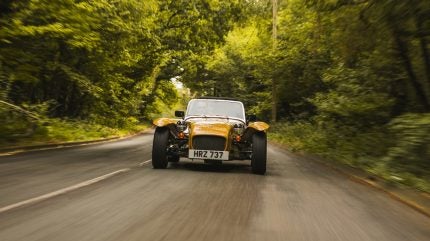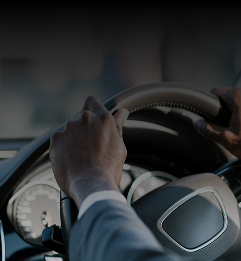
The first thing to know about getting into any Caterham Seven is how cosy the fit is. In fact, taller folk may find just trying to slide in and out a bit of a challenge. Luckily for average height and weight me, swinging myself aboard was pretty straightforward. Getting out can be inelegant but, practice makes (almost) perfect I learned.
Now based in Kent at a big new factory, this tiny firm seems to have a thriving business. I also had a look around the Dartford build base which serves as company HQ. Some staffers still commute from their homes near where Caterham was based for decades (i.e. the Surrey town of the same name), which probably shows how much they enjoy working for the company.

Discover B2B Marketing That Performs
Combine business intelligence and editorial excellence to reach engaged professionals across 36 leading media platforms.
During my tour, I saw many customers’ motorsport cars being fettled as well as various models being put together. Two paint booths look state of the art but aside from this area of the factory, it’s very much a hand-assembly operation. And customers love that. Certain parts are created on site but the basic chassis is fabricated by a specialist firm in Wiltshire.
Atmo or supercharged 2.0-litre
A turbocharged Suzuki engine with just 84 bhp is offered in the entry level Seven 170 while a couple of Ford alternatives also exist. A naturally aspirated Duratec 2.0-litre is the next step up, power being 180 or 210 bhp. You can have a 310 bhp one too, thanks to supercharging, while a new ‘Academy Race Package’ instead has a 130 bhp 1.3 Horse-sourced unit under its featherweight metal bonnet.
Every friend and neighbour who saw me in the Seven wanted to know the same thing. That being is this a kit car (yes, you can also order one in this form) and is it as much fun as the low stance and looks suggest? Even more so. With perhaps one caveat, and this from me who drove from Dartford to Somerset via the M25 and M3, whilst also making the return trip: wonderful in spring, summer or autumn but likely less so during winter.
I mostly kept the vinyl roof on, though it’s very easy and quick to remove or attach once you know the recommended method. In this regard, the Seven is a lot like so many old British roadsters thanks to a system of press studs, most of which manage to keep the top in place even at 60+ mph on motorways. And hey, it’s fun to stay in the slow lane, occasionally switching to the middle one, seeing the smiles from those passing you. Just make sure any overtaking HGV driver sees you: the Seven is oh so low. How low? A passenger in a 911 grinned as she looked down on me.
Mind your leg
Unlike the previous example I drove a couple of years back, the exhaust just below the driver’s door didn’t get too hot (watch your leg getting out if wearing shorts) and the steering wheel is fixed. In the 170 this would be detached each time you exited or entered the car: a clever anti-theft arrangement.
The press test Super Seven 2000 was instead specified with a fixed timber steering wheel. Lovely to look at, it could occasionally become a little slippery though it did match the tan exterior and dashboard in an appealing way.
No glovebox so where to stash small stuff?
Each of the two seats provides a very snug fit and neither is adjustable. You can though easily lift out the base. Which means small valuables can be hidden below either one, or even just things that could be at risk of blowing away.
When the roof has been left in the owner’s garage or carefully folded into what passes as a boot (a space behind the seats), you really can’t drive the Seven without grinning from ear to ear. And everyone can see you doing so. Which tends to make them do the same thing. Further, each door easily lifts off should you want the total open-air feeling.
No power steering, no problem
Leaving the factory floor, I was relieved not to stall the SS2000 and even selected the correct ratio (i.e. not third). You soon get used to sensing where first and reverse are, the clutch pedal is light and the change itself makes the gearbox in a Mazda MX-5 seem vague by comparison. It really is that precise and demands purposeful pushes. I also soon overcome a fear of slotting the wrong gear at higher revs.
One of multiple especially engaging things is a centrally-positioned, flashing red toggle: flick left or right for each direction of the turn signals and back to straight ahead for off. Simple, plus an insistent beep means you never forget to cancel either indicator.
Tiny chrome (not black) windscreen wipers
Dinky wipers are also a delight and surprisingly effective. The same applies to a rudimentary fan which has a heater setting and while there is no demister on the plastic back window, the windscreen does have heated elements. Air conditioning? Afraid not.
After a few close calls with accidentally touching the wrong pedal, any owner with wide feet might end up removing their shoes as a habit. Me, I soon became used to how close the pedals are to one another. That’s another thing you tend to forget worrying about as there are so many great experiences to savour. Such as seeing the suspension working, reflected on the backs of the pod-like headlights.
The national speed limit is thrilling enough
Your inner kid will utterly love any Seven and the SS 2000 may even be the pick of the range: it’s ridiculously light and has just the right amount of power. I was also very happy at half the claimed 130 mph top speed as the senses are treated to so much excitement.
Corners are the Super Seven 2000’s speciality and as you get ever less cautious, knowing there is no traction control (nor ADAS), the car’s inherent balance and therefore feeling of safety come to the fore.
Good news for taller customers
I don’t know how strong the windscreen’s metal supports would be should the worst happen but the tubular roll-over bars and its two braces behind the seats do look and feel sturdy. And basic rear-end shunt protection exists in the form of the spare wheel/tyre: this sits on a special carrier between the tail lights.
A couple of other options besides the roll bars (GBP 750) include a low floor (GBP 600) plus something else for the lankier clientele, this being a ‘large chassis’ (GBP 2,750). You may also request a limited-slip differential (GBP 1,250) and/or sports suspension/ rear anti-roll bar (GBP 800/220).
Summary
In many ways it’s incredible that the Caterham Seven still exists, so different is it to almost every other car. And therein lies so much of the appeal.
Caterham pricing starts at GBP 29,490 (Seven 170) and goes as high as GBP 79,995 (Seven CSR Twenty), while the as-tested Super Seven 2000 costs GBP 40,990 excluding options. For the SS 2000, factory build is GBP 2,595. Weight is just 560 kg and 0-60 mph takes 4.8 seconds.




